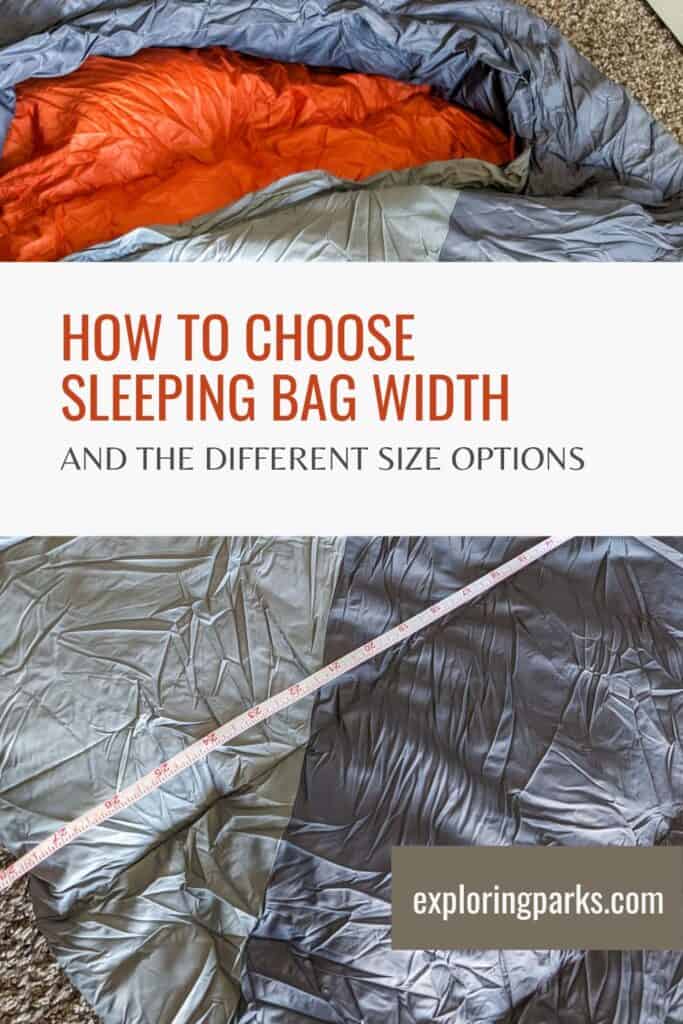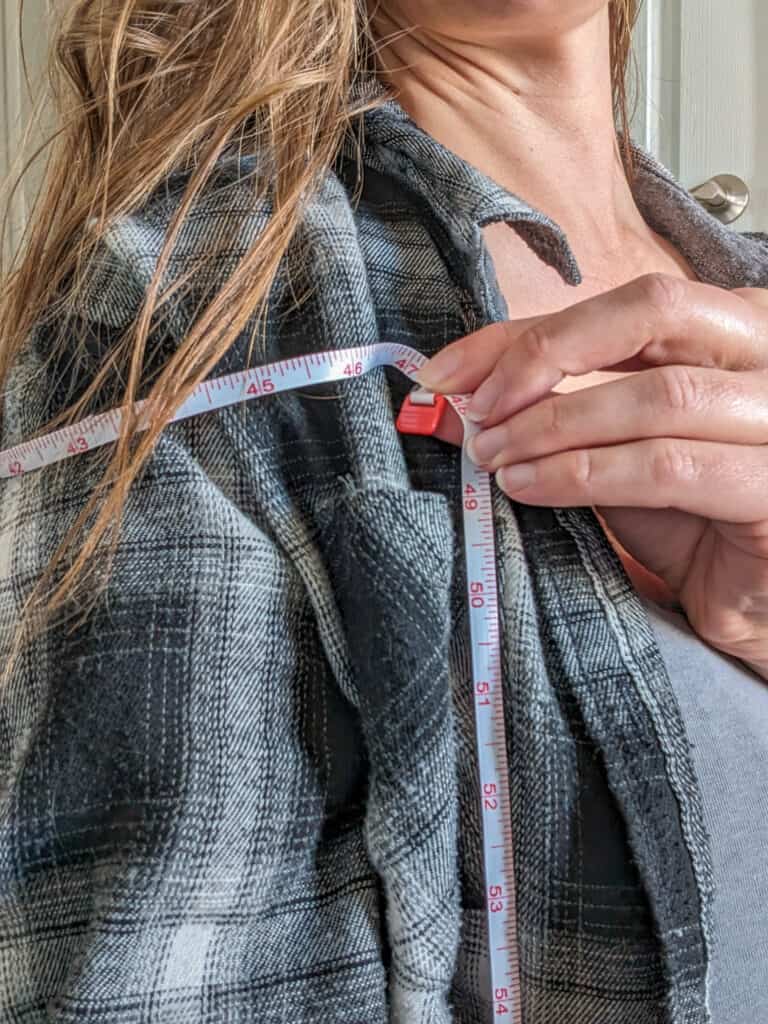How Wide Is A Sleeping Bag? (Best Size For You)
There are many factors to consider when choosing a sleeping bag. Usually, we put a main focus on the length of the sleeping bag, but the width is just as important. When picking from the best sleeping bags, you want to make sure the hip and shoulder width will be spacious enough for you, while also retaining body heat.

This page contains affiliate links, which means I make a small commission at no extra cost to you. See full disclosure here.
How Wide Is A Sleeping Bag?
Sleeping bags come in a few different sizes, therefore it is important to choose the best size for you. Paying attention not only to how long, but also how wide a sleeping bag is will be the easiest way to choose the best sleeping bag size for you.
Sleeping bag widths can vary based on the type of bag. In general, when measuring the circumference of the sleeping bag, men’s sleeping bags have a width between 60-64 inches around the shoulders & 58 inches around the hips. Women’s bags are generally smaller around the shoulders at 56-60 inches and wider around the hips at 60 inches.
How To Choose Your Sleeping Bag Width
After you know your shoulder circumference measurement, then you’ll add roughly 10 extra inches to determine the width for your sleeping bag. If your shoulder measures 56 inches, then you’ll want to find a sleeping bag with a shoulder width (also known as girth) of 66 inches for the most comfort.
Width of Men’s Mummy Sleeping Bags
In general, men’s sleeping bags are going to be longer and wider than women’s. It is also really common for women to use a men’s sized sleeping bag because there is usually a wider variety of adult men’s bags to choose from.
Aside from men’s sleeping bags being longer in length, they also are wider around the shoulders. Because men typically have broader shoulders, the shoulder width of a men’s bag is usually between 60-64 inches.
The width of the hip (also known as the hip girth) is a bit more narrow than the women’s bag. Typically a men’s mummy style sleeping bag has around 58 inches for the hip width.
Width of Women’s Mummy Sleeping Bags
Women’s sleeping bags are usually a bit shorter and wider around the hips.
The shoulder width on a women’s mummy style sleeping bag is typically more narrow, as women have smaller shoulder girth than men. The shoulder girth on a women’s sleeping bag is around 56-60 inches.
The hip width on a women’s sleeping bag is wider than mens’ at around 60 inches.

How Wide Is A Rectangular Sleeping Bag?
If you’re looking for some extra room, you might opt for a rectangular sleeping bag or a semi-rectangular bag. The rectangular shape offers a few extra inches in width when compared to a mummy bag.
The width of a rectangular sleeping bag is usually around 66 inches wide along the whole length of the sleeping bag.
Depending on what type of year you are camping, these roomier bags might be a better option for you. If you’re camping during cold weather, then you might lose more body heat based on the extra space.
Why Is Sleeping Bag Width Important?
Just like the length of a sleeping bag, the width will also help with the sleeping bag performance. If your sleeping bag is too tight, then your body will compress the insulation. This can lead to cold spots in your sleeping bag, making it harder to keep warm at night.
You also don’t want too much space around you in your sleeping bag. This can lead to a lot of body heat loss. The heat will escape in the extra space when your sleeping bag is too wide around you.
This is also the main reason that there is a difference between how wide a man’s sleeping bag is vs. a woman’s sleeping bag. Women are typically cold sleepers compared to men, so it’s important that there are proper width sizes of sleeping bags for women to keep extra warm while they sleep as opposed to using a men’s-size sleeping bag.

How To Choose The Right Sleeping Bag Width
Having the right width of sleeping bag can make or break your night of sleep. You want to have the perfect sweet spot in width. You don’t want too much space around you so you’re losing body heat. But you also want to make sure you have enough space for freedom of movement while sleeping.
The best rule of thumb when deciding if your sleeping bag fits your width is to measure yourself. You want to measure the circumference around your shoulders, and possibly even around your hips depending on the style of sleeping bag you’re looking at.
After you know your measurements, then you’ll want roughly 10 extra inches added to the circumference measurement of your shoulders for your sleeping bag width. If your shoulder measures 56 inches, then you’ll want to find a sleeping bag with a shoulder girth of 66 inches for the most comfort.

Extra Wide Sleeping Bags
If your shoulder width is wider than what a typical single sleeping bag offers, then you might opt for a double sleeping bag. Double sleeping bags are designed to be wider to fit two people, but a double-wide sleeping bag could also work well if you’re looking for some extra width in your sleeping bag.
There are also some options of extra large single-person sleeping bags available with wider shoulder girth if your shoulders need more space.
REI has a list of wide sleeping bags to choose from. Some of these bags are 70-80 inches wide, giving plenty of extra space.
Other Specs To Consider In Your Sleeping Bag
Besides the width of the sleeping bag, there are a few other aspects that you want to consider for the best night of sleep.
You’ll also want to have the right length, the right temperature rating, and the right insulation.

Length of Sleeping Bags
The length of a sleeping bag is typically one of the first things we measure. Undersized bags are not only uncomfortable, but they can lead to cold spots due to the insulation being compressed.
Typical Sleeping Bag Sizes are:
| Small | 5 feet 3 inches (5’3”) |
| Medium | 5 feet 9 inches (5’9”) |
| Regular | 6 feet (6”) |
| Long | 6 feet 6 inches (6’6”) |
There are different lengths of sleeping bags to choose from. You want to choose the right length based on your own height. For example, if you’re 6 feet tall, then a 6-foot sleeping bag is designed for you.
What they don’t tell you is that there is usually an additional 6-8 inches on top of the listed sleeping bag length. This is due to our feet stretching downwards and our body lengthening as we lay down. This is good to know so that you can choose the proper length if you are right on the border of two sizes.
For example, if you are 6 feet 2 inches tall, then you can still choose the lower limit of a regular 6 foot sleeping bag because there is actually an extra 6-8 inches of length in the sleeping bag.

Temperature Rating
Temperature rating is another important thing to consider when choosing your sleeping bag. Sleeping bags typically have a temperature rating to let you know how cold it can be when you’re camping on cold nights without causing you harm.
Usually the “temperature rating” is different from the “comfort rating.” For example, if you’re sleeping in 30 degree weather, you’ll probably want at least a 40 degrees f sleeping bag to ensure you’ll feel warm in your bag. The 30 degree rating is showing the lowest temperature that you can sleep in, but not necessarily be comfortable in.
Aside from the temperature rating, many sleeping bags are designed to retain your body heat with features such as a draft collar and insulated zipper wells. Knowing how wide your sleeping bag should be will also play a role in the thermal efficiency of the sleeping bag.
Type of Insulation
In general, there are two types of insulation to choose from: synthetic or down. Both have pros and cons, but either can work for your trip.
The short version is that synthetic bags are cheaper and a bit more versatile, but heavier in weight. Down bags are less weight, but require more care, and cost a bit more.
The insulation won’t affect the length and width of your sleeping bag, but it will affect the weight and how warm it keeps you.
You want to figure out the best warmth-to-weight ratio for your sleeping bag, especially if you’re going to be backpacking. The warmer the bag, the heavier the weight.
Also, extra insulation means it will usually take up more surface area in your backpack. Using a stuff sack can help reduce the size of the packed sleeping bag, but it won’t reduce the weight.

Sleep System
The other parts of your sleep system should fit you properly as well. It is important to have the right size & rated sleeping pad, sleeping sheet, pillow, & any other sleep components that you’re bringing on your trip to ensure the most comfort.

Conclusion
Choosing the perfect sleeping bag will largely depend on the length, temperature rating, and how wide the sleeping bag is. In order to have a good night’s sleep, it is a good idea to measure yourself and choose the right width of sleeping bag based on your own measurements.
Related Posts
How To Choose Rectangular Vs. Mummy Sleeping Bag
How To Roll Up Your Sleeping Bag
How To Stay Warm In A Sleeping Bag
How To Attach Sleeping Bag To Backpack
How To Wash Dishes While Camping
Easy DIY Cotton Ball Fire Starters (Long Burning)
How To Use A Camping Stove Indoors (Or In Tent)
How To Choose Hammock vs. Tent Camping
Gazelle T4
Hub Tent

Jackery Solar
Generator

Qomotop Self-Inflating Mattress

THERMACELL MOSQUITO REPELLER

